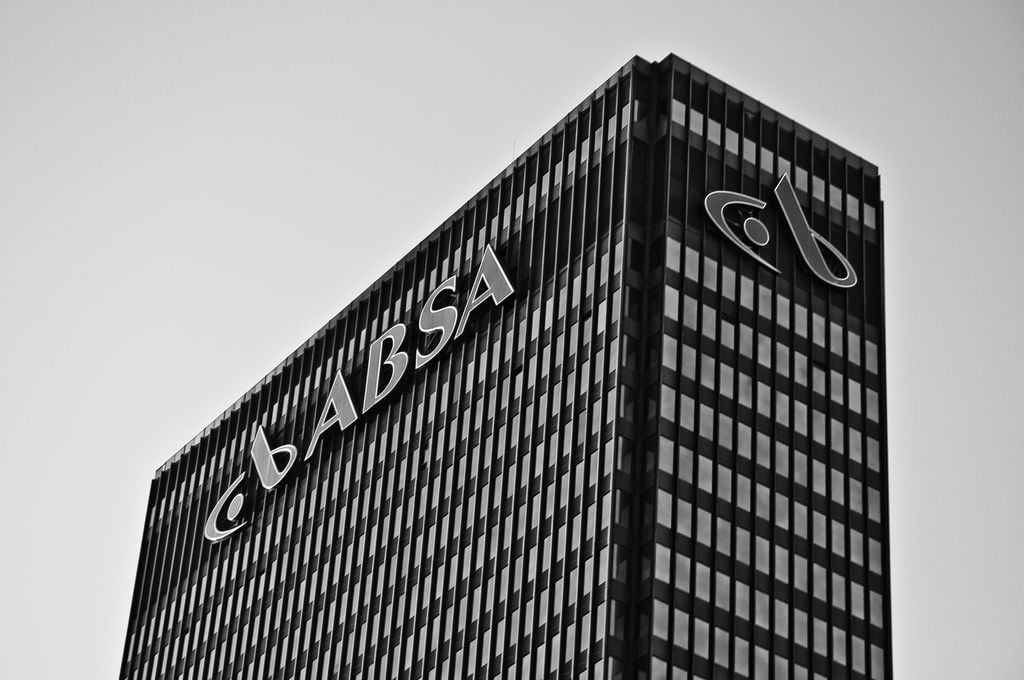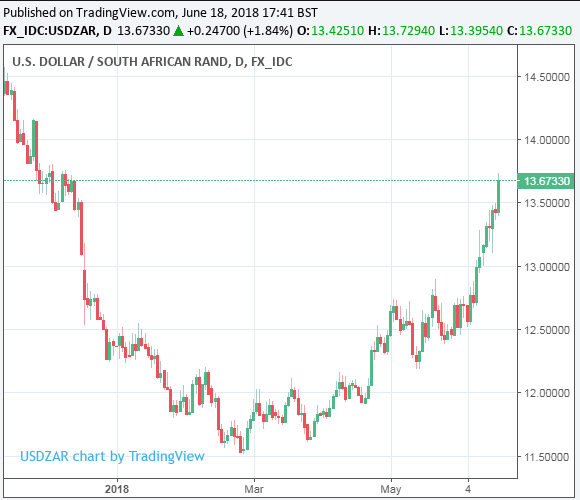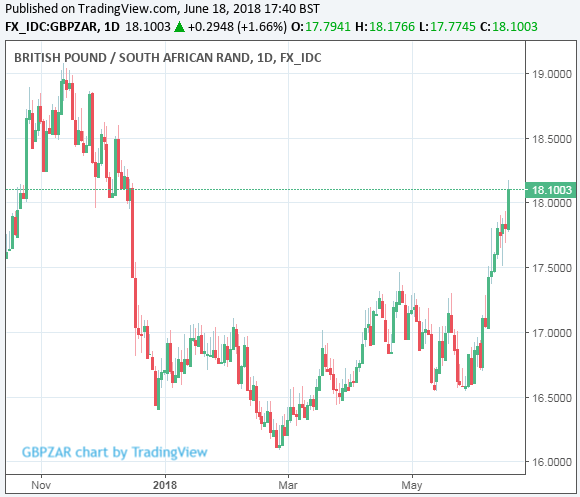South African Rand Downgraded at ABSA
- Written by: James Skinner
- ZAR forecasts downgraded by ABSA
- But ZAR still has scope to rebound short-term.
- South African inflation, current account, in focus this week.

© Richard Atkinson, reproduced under CC licensing
The South African Rand fell sharply against the Pound and Dollar this week as emerging market currencies remain under pressure in the face of renewed geopolitical tensions, and now one of South Africa's most prominent lenders has cut its forecasts for the currency due to concerns over a sluggish economy.
Fears over a so-called trade war are resurgent this week after the White House instructed US trade representatives to prepare a 10% tariff on US imports of more than $200 billion in Chinese goods, which has already drawn a threat of retaliation from the Chinese Ministry of Commerce and may have far-reaching implications for the global economy.
This comes hard on the heels of a decision last Friday to push ahead with other tariffs on nearly 1,000 Chinese industrial products, to be implemented on July 06, which also drew threats of retaliation. Both moves come despite President Trump having said in May that China has agreed to substantially increase its imports of US agricultural goods in order to reduce the trade deficit.
Concerns are that the tariffs will lead to slower economic growth in the US and China while furthering a growing trend toward so called "protectionsism". The tariffs are bad for emerging market currencies like the Rand because they damage investor confidence and chip away at financial market's appetite for risk, which typically leads to a stronger US Dollar and weaker emerging market universe.
"The ZAR has not yet weakened to the same extent as some of its high yield and commodity based peers but large-scale portfolio outflows are taking place at a time when SA’s current account deficit is starting to widen again. A firmer USD environment and SA’s persistently sluggish economic recovery have also prompted us to become more bearish about the ZAR," says Peter Worthington, a senior economist at ABSA Bank, a part of Barclays Africa Group.
Worthington and the ABSA team have downgraded their forecasts for the Rand relative to the Dollar and Pound at the end of this month and for the year overall. Their projections still imply potential for a rebound in the short-term, but suggest the Rand will weaken again before the year is out.
ABSA now predicts the USD/ZAR rate will see out the month at 13.10, which implies a steep fall from the 13.85 level seen Tuesday but nonetheless marks a deterioration from the 11.75 forecast they had penciled in just last week.
Meanwhile, the Pound-to-Rand rate will fall to 16.96 in June, a donwgrade for the Rand from the 16.45 penciled in previosuly, which implies a steep fall from Tuesday's 18.22 level.
For the year overall, ABSA forecasts the USD/ZAR rate will rise to 13.90 before the end of December while the Pound-to-Rand rate is expected to settle around 18.25.

Above: USD/ZAR rate shown at daily intervals.
The USD/ZAR rate was quoted 1.44% higher at 13.85 Tuesday and is now up by 11.98% for the 2018 year-to-date. The Pound-to-Rand rate was 0.69% higher at 18.24 and is now up by 9.5% for 2018.

Above: Pound-to-Rand rate shown at daily intervals.
Advertisement
Get up to 5% more foreign exchange by using a specialist provider to get closer to the real market rate and avoid the gaping spreads charged by your bank when providing currency. Learn more here
Data and Events to Watch for the Rand this Week
The week ahead in South Africa sees the economic data calendar return to life with a series of key releases scheduled for the days ahead, including the latest inflation reading and the all-important current account data for the first-quarter.
May's inflation number will be released Wednesday at 09:00 London time and is expected to show the consumer price index falling by 30 basis points to 4.6% during the recent month. The "core" inflation rate, which removes volatile food, energy and other commodity items from the goods basket measured, is expected to rise 10 basis points to 4.5%.
This will be important for market expectations of interest rates, which are a central banks primary tool for controlling inflation, with rates typically being lifted to curtail inflation and cut to stoke inflation. The headline inflation number is comfortably below the 6% upper band of the South African Reserve Bank target and falling, but the more important "core" rate is rising toward the midpoint. It is not clear how the market will view this.
Given that expectations of a first-quarter widening in the South African current account deficit have played such a promiment role in the deterioration of sentiment toward the Rand, alongside the "trade war" spectacle, Thursday's current account data will be watched closely by the market and shall be key to analyst expectations for the currency going forward.
The data is set for release at 09:00 am London time Thursday. Consensus is for the deficit to have risen to -ZAR177 billion during the first-three months of the year, nearly doubling the ZAR-100 billion black hole seen in the fourth quarter of 2017. Currency markets will be sensitive to both positive and negative surprises in the number.
The current account is best thought of as a nation's bank balance with the rest of the world. It records capital flows both into and out of a country, setting them off against eachother to gauge the balance of fund flows. It also records government borrowing from overseas as a negative in balance, like an overdraft, as such flows are future liabilities to the rest of the world. Markets care about the data because it provides insight into real world demand for a given currency.
Data and Events to Watch for the Pound this Week
The week ahead in the UK sees the economic data calendar fall quiet after an action-packed five day period that saw industrial production figures for April underwhelm the market, while unemployment data showed the labour market remaining in rude health in May and retail sales figures showed consumer spending coming back with a bang during the recent month.
The Bank of England interest rate decision for June is the sole event of importance in the calendar for Sterling, due at 12:00 pm Thursday, and markets are looking for the central bank to hold rates steady at their current 0.50% level.
It isn't forecast to make changes to any other aspects of its monetary policy either, although markets will scrutinise the contents of the statement closely for clues as to how the Bank's views on the economy may have changed since its May meeting.
Economists and markets are currently looking to the August 02 monetary policy announcement for the next possible BoE rate hike. Pricing in interest rate derivatives markets implied an August 02 Bank Rate of 0.56% on Friday. If markets were really that confident about the BoE raising rates anytime soon then that implied rate would be somewhere closer to 0.75%.
Markets will also keep a close watch on the White House, China and European Union for signs of an escalation in the so called "trade war" after the US administration listed a large number of Chinese export goods that will be targeted by US tariffs over the coming days.
The move advances an earlier plan to pressure China into changing some of its trade practices and to voluntarily reduce its bilateral trade deficit with the US, but it also risks riling global financial markets if it looks at any point as if the two countries could be about to renew an earlier tit-for-tat tariff fight.
Tensions between the US and EU are also running high after President Trump slapped tariffs onto their steel and aluminium exports to the US.
Advertisement
Get up to 5% more foreign exchange by using a specialist provider to get closer to the real market rate and avoid the gaping spreads charged by your bank when providing currency. Learn more here




